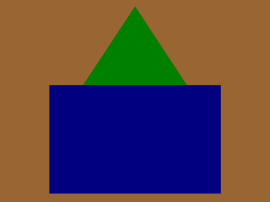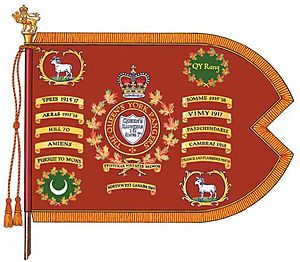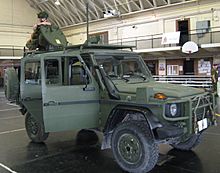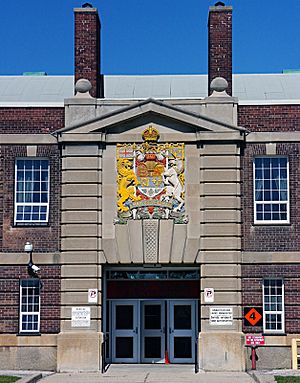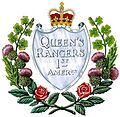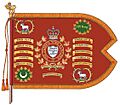The Queen's York Rangers (1st American Regiment) (RCAC) facts for kids
Quick facts for kids The Queen's York Rangers (1st American Regiment) R.C.A.C. |
|
|---|---|
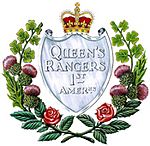
The Queen's York Rangers crest
|
|
| Active | 14 September 1866 in its current form (1775 as the Queen's Rangers) - Present |
| Country | |
| Branch | |
| Type | Armoured Reconnaissance |
| Role | To obtain timely and accurate information on the enemy and ground and pass it up the chain of command quickly |
| Size | One Regiment, including Band, Cadets |
| Part of | 32 Canadian Brigade Group 4th Canadian Division |
| Garrison/HQ | Fort York Armoury, Toronto, Ontario |
| Nickname(s) | QY RANG (Kwai-rang) |
| Motto(s) | Latin: Pristinae Virtutis Memor (Remembering their glories in former days) Celer et Audax (Latin: Swift And Bold) |
| Colors | Green and Amethyst Blue |
| March | Braganza |
| Commanders | |
| Colonel of the Regiment | Her Honour, Elizabeth Dowdeswell, OC, DStJ, O.Ont, Lieutenant Governor of Ontario |
| Honourary Colonel | Honourary Colonel Sally M. Horsfall Eaton, C.M., CD, SSStJ, RN, LL.D |
| Honourary Lieutenant-Colonel | Honourary Lieutenant-Colonel Clint Davis, MPA, LLB |
| Commanding Officer | Lieutenant-Colonel James J. Stocker, CD, AdeC |
| Regimental Sergeant-Major | Chief Warrant Officer Chris Duncan, CD |
The Queen's York Rangers (1st American Regiment) R.C.A.C. is a special part of the Canadian Army. It is a Primary Reserve regiment that means its members are part-time soldiers. They are based in Toronto and Aurora.
This regiment is part of the 4th Canadian Division's 32 Canadian Brigade Group. It has one reconnaissance squadron, which gathers information, and a Headquarters and Training Squadron. The Rangers also have a volunteer band and two Royal Canadian Army Cadets groups. Their motto, Pristinae Virtutis Memor, means "Remembering their glories in former days." People often call them the Rangers or "K'why Rang."
Contents
The History of the Queen's York Rangers
How the Regiment Started
The Queen's York Rangers have a long history. They began with Robert Rogers and his Rangers in 1756. This was during the French and Indian Wars. After that war, the Rangers were temporarily stopped.
In 1775, Rogers started the Rangers again. They became known as the Queen's Rangers, First American Regiment. They were very brave in battles like the Battle of Brandywine in 1777.
The Rangers in Upper Canada
After the war in 1783, the Rangers moved to New Brunswick. When John Graves Simcoe became the first Lieutenant Governor of Upper Canada, he brought the Queen's Rangers with him in 1793. They helped build up the new area.
The Rangers were stopped again in 1802. Their role was then taken over by the York Militia. This group became active again during the War of 1812. They also helped during the Upper Canada Rebellion in 1837-38.
Becoming the York Rangers
On September 14, 1866, the York County Militia was officially reformed. It was called the 12th "York Battalion of Infantry". Over the years, its name changed several times.
In 1872, it became the 12th Battalion of Infantry or "York Rangers". Then, in 1900, it was the 12th Regiment "York Rangers". After the First World War, in 1920, it was simply The York Rangers.
Joining Forces and Modern Name
On December 15, 1936, The York Rangers joined with another group called The Queen's Rangers, 1st American Regiment. They became The Queen's York Rangers (1st American Regiment) (MG).
Since then, the regiment's name has changed a few more times. In 2004, it became The Queen's York Rangers (1st American Regiment) (RCAC), which is its current name.
Important Leaders of the Regiment
In 2011, the Minister of National Defence made a special decision. The Lieutenant Governor of Ontario is now always the unit's Colonel of the Regiment. This special role honors the regiment's connection to John Graves Simcoe. He was the first Lieutenant Governor of Upper Canada and led the Rangers during the American Revolutionary War.
What the Rangers Have Done
North West Rebellion (1885)
The 12th Battalion of Infantry (York Rangers) helped during the North West Rebellion in 1885. Four of their companies served with the York and Simcoe Provisional Battalion. They were part of the Alberta Column.
The First World War (1914-1918)
Several battalions that are now part of the Rangers fought in the First World War.
- The 20th Battalion (Central Ontario), CEF went to France in 1915. They fought bravely in many major battles. These included the Battle of the Somme, Vimy Ridge, Hill 70, and Passchendaele. Two of their soldiers, Lt Wallace Lloyd Algie and Sergeant Frederick Hobson, received the Victoria Cross. This is a very high award for bravery. The 20th Battalion had 4,310 soldiers. Sadly, 843 were killed and 1,855 were wounded.
- The 35th Battalion, CEF helped by sending new soldiers to the Canadian forces fighting in the war.
- The 127th Battalion (12th York Rangers), CEF became a railway battalion. They built and maintained railways for the British Army in France. In April 1918, they even fought as infantry near Amiens. They showed great courage and held their ground against German attacks.
- The 220th Battalion (12th Regiment York Rangers), CEF also provided new soldiers for the Canadian forces.
The Second World War (1939-1945)
When the Second World War began, parts of the regiment were called to duty. They helped with local protection in Canada.
Later, the 1st Battalion, The Queen's York Rangers (1st American Regiment), CASF was formed. They served in Canada for home defense. Over 2,000 Rangers served in the Second World War. Many of them joined other regiments to fight overseas.
Battle Honours
Battle honours are special awards given to military units for their bravery in battles. The Queen's York Rangers have many battle honours. Some of these are from the battalions that became part of the Rangers. The honours in bold are displayed on the regimental guidon, which is like a special flag.
- War of 1812:
* Defence of Canada – 1812–1815 * Detroit * Queenston * Niagara
- North West Rebellion:
* North West Canada, 1885
- First World War:
* Ypres, 1915, '17 * Somme, 1916, '18 * Arras, 1917, '18 * Vimy, 1917 * Hill 70 * Passchendaele * Amiens * Cambrai, 1918 * Pursuit to Mons * France and Flanders, 1915–18
- South-West Asia:
* Afghanistan
Alliances with Other Regiments
The Queen's York Rangers have special connections with two regiments in the United Kingdom:
 United Kingdom - The Princess of Wales's Royal Regiment (Queen's and Royal Hampshires)
United Kingdom - The Princess of Wales's Royal Regiment (Queen's and Royal Hampshires) United Kingdom - The Yorkshire Regiment (14th/15th, 19th and 33rd/76th Foot)
United Kingdom - The Yorkshire Regiment (14th/15th, 19th and 33rd/76th Foot)
The Regimental Band
Since the 1970s, the regiment has had a volunteer band. In 2009, a group called the Streetsville Pipes and Drums agreed to also perform as the Regimental Band of The Queen’s York Rangers.
The Queen's York Rangers Museum
The Queen's York Rangers (1st American Regiment) (RCAC) Museum collects and shows the history of the regiment. It helps both the soldiers and the public learn about their past. The museum works with other museum organizations in Canada.
Armouries (Regimental Homes)
The Queen's York Rangers have used different armouries over the years. These are buildings where military units train and store their equipment.
- Aurora Armoury: This building in Aurora, Ontario was built in 1874. It was the oldest purpose-built armoury used by the military in Ontario until 2014. It is now owned by the Town of Aurora.
- Fort York Armoury: Located in Toronto, Ontario, this large building was built between 1933 and 1935. It is the current home of The Queen's York Rangers.
Images for kids


